The Samsung Galaxy S7 and S7 edge Review: Part 2
by Joshua Ho on July 5, 2016 8:00 AM ESTCamera Architecture and UX
In general, camera has become probably the single biggest point of differentiation between smartphones at this point. As smartphones are often the only camera that most people carry on a day to day basis, the rear camera on a smartphone really cannot be a disappointment relative to the competition. While we can talk about how much a front-facing camera matters in terms of quality, it’s pretty safe to say that for photos and videos that are worth saving will be taken with the rear-facing camera.
While post-processing and a number of other factors are going to have a huge impact on the overall camera experience, the foundation that makes it possible to deliver a great camera is always going to start at the hardware.
| Samsung Galaxy S Cameras | ||||
| Galaxy S6 Galaxy Note5 |
Galaxy S7 | |||
| Front Camera | 5.0MP | 5.0MP | ||
| Front Camera - Sensor | Samsung S5K4E6 (1.34 µm, 1/4.1") |
Samsung S5K4E6 (1.34 µm, 1/4.1") |
||
| Front Camera - Focal Length | 2.2mm (22mm eff) | 2.1mm (21mm eff) | ||
| Front Camera - Max Aperture | F/1.9 | F/1.7 | ||
| Rear Camera | 16MP | 12MP | ||
| Rear Camera - Sensor | Sony IMX240 Samsung S5K2P2 (1.12 µm, 1/2.6") |
Sony IMX260 Samsung S5K2L1 (1.4 µm, 1/2.6") |
||
| Rear Camera - Focal Length | 4.3mm (28mm eff) | 4.2mm (26mm eff) | ||
| Rear Camera - Max Aperture | F/1.9 | F/1.7 | ||
In the case of the Galaxy S7, Samsung has done something that I thought they’d never do, which is move backwards in resolution in order to improve pixel sensitivity. In the case of the Galaxy S7, Samsung has moved from the Sony IMX240/Samsung S5K2P2 to the Sony IMX260/Samsung S5K2L1 sensor, with a 1.4 micron pixel size relative to a 1.12 micron pixel pitch in the previous generation. This means that there’s a 56% increase in sensitivity per pixel. Assuming the same process technology, this does improve low light performance significantly. While to some extent it’s true that improved CIS (CMOS image sensor) technology can alleviate the downsides of smaller pixels, on the same technology you have to reduce your fill factor/active sensor area. The other problem is that while read noise on the sensor does reduce per pixel as you reduce pixel size, the overall sensor read noise trends upwards. This means that the region in which the CIS noise is primarily limited by shot noise is going to be smaller as you reduce pixel size. Shot noise is an unavoidable reality of existence, to the extent that even our eyes can see this “visual snow” if ambient light is sufficiently dim.
However, in the case of the Galaxy S7 I suspect that there’s more to the story, because the dual pixel AF system means that for each 1.4 micron pixel each pixel needs two photodetectors. In order to make phase detection work, there has to be sufficient spatial separation to make this system work properly, so some of the benefit of these larger pixels will inevitably be eaten up in order to enable PDAF that works in basically all lighting conditions.
The other notable change here is that the Galaxy S7 uses an even wider f/1.7 aperture. Unfortunately, in Samsung's efforts to try and make the module thinner they've made the focal length slightly shorter than before which results in an effective focal length of 26mm. This and the wider aperture could lead to compromises as light is entering the optics at a more extreme angle than before.
With these basics covered, we can move on to a discussion of the user experience. While in the past it was easy enough to just take some still shots on a tripod, a holistic view of camera quality really needs to take into account far more than just the end result. A poorly designed camera application with low resolution, low frame rate preview, improper preview aspect ratio, poor control layout, and other issues can easily make it difficult, if not impossible to get the photo that you want. These issues are thankfully getting less common, but these problems can make it almost impossible to recommend a phone for its camera, no matter how good the results are.
In the case of the Galaxy S7, the camera application is a nice upgrade over the Galaxy S6 at launch, but for the most part nothing is really different this go around. I’m not going to spend too much time here, but the short story is that I don’t think that Samsung is doing anything wrong here, and things are pretty much as good as they’re going to get.
While leaving it at that would be enough, I want to recognize some of the improvements that Samsung has implemented here. The major improvement here is that Pro mode is finally useful, as this mode now allows for adjusting auto-exposure and AF targets, in addition to EV, shutter speed, ISO, white balance with 100K granularity, and manual focus. The one notable shortfall here is that Samsung only allows 800 ISO max in manual ISO mode when the true maximum is 1250. For better or worse though, that’s the only notable problem I encountered with the camera app itself. It’s easy to think that Samsung hasn’t done anything notable here, but this is more a testament to the execution of design more than anything else.
However, before we move on to image quality testing, we can take a look at our focus and capture latency tests. For those that are unfamiliar, this is a fairly simple test designed to see how long it takes for a phone to focus and capture a scene on our standard ISO test chart in good lighting conditions, which can give a fairly good idea for best case latencies.
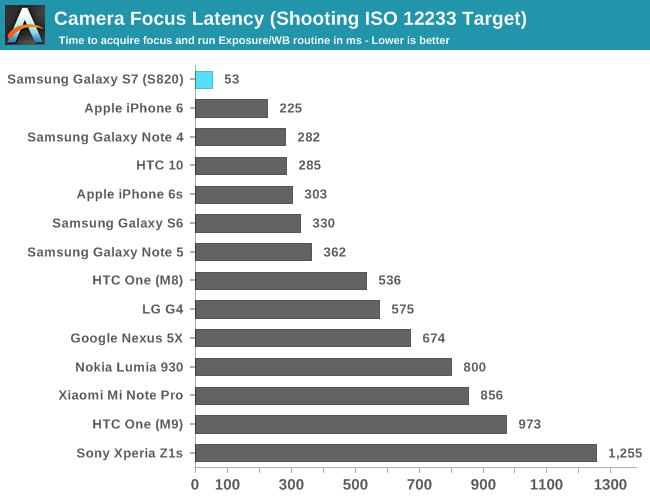
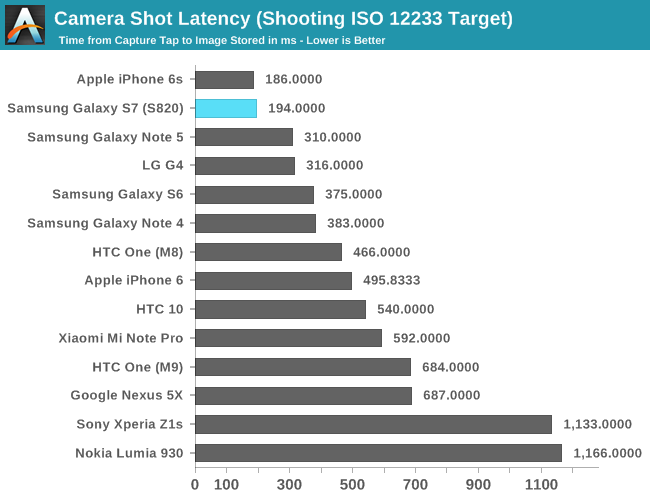
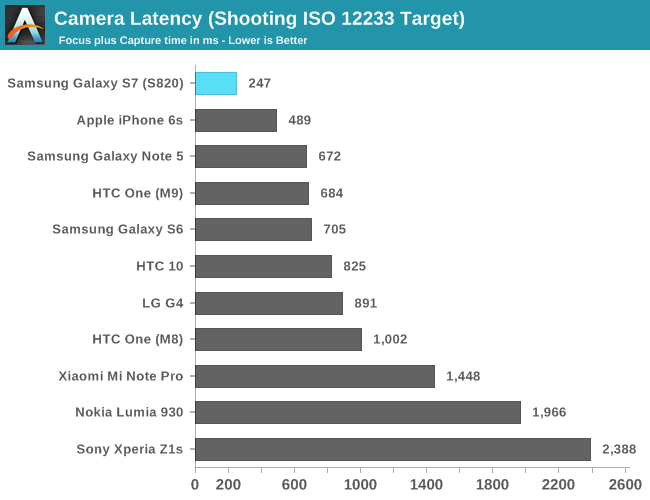
It’s probably not a surprise, but the Galaxy S7 is really, absurdly quick to take photos and focus. There is nothing out there that can realistically match the dual pixel AF system in the Galaxy S7, especially once you get into low light scenarios where traditional PDAF systems are overwhelmed by noise that can’t be easily canceled out. Samsung’s sheer prowess in semiconductor design and manufacture is really showing here, even in the best case.


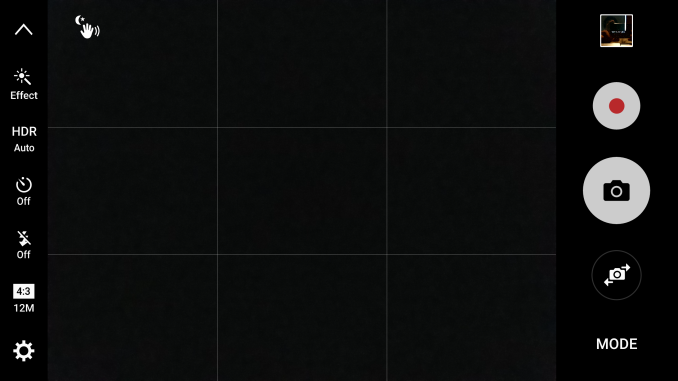
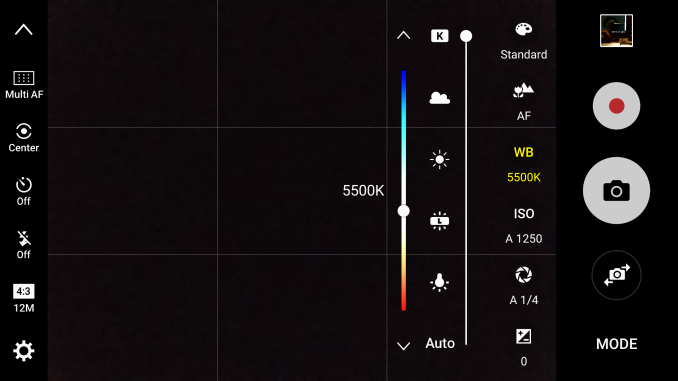
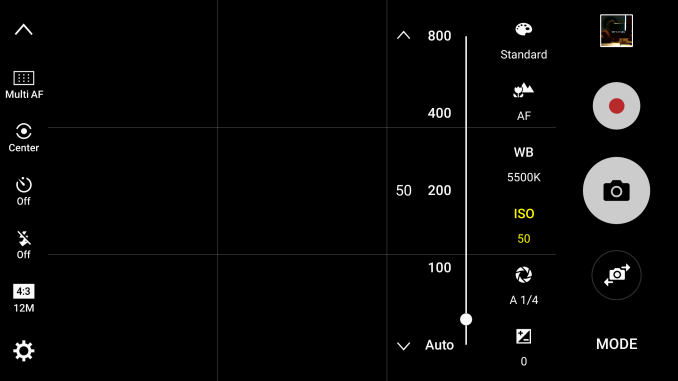








266 Comments
View All Comments
shm224 - Thursday, July 14, 2016 - link
any idea why Anandtech is still using web/javascript benchmarks that are intended to measure software/javascript engine performance to measure the system / SOC performance?ozmick1 - Saturday, July 16, 2016 - link
The material (Samsung has told me plain glass and plastic) used over the rear camera lens if too fragile. Many owners are starting to complain of it breaking for no apparent reason as reported on Samsung's US Community website. Buyer beware with the S7 as it made from not-fit-for-purpose material. Samsung even told me that to prevent the rear lens from breaking - to leave the phone on the desk. Buyer beware with the S7.FourEyedGeek - Monday, July 18, 2016 - link
I just got the phone and I really like it. I used the Samsung Galaxy S6 Edge for a couple of months and wasn't a fan, this is better in all the little things.The phone is snappy, interface moves smoothly and opening up applications leaves me with minimal load times. Mine has 32GB but is backed up with 200GB, I move large applications over to the SD card as a way of keeping the inbuilt a free as possible.
It takes high quality pictures, not as nice as my DSLR but still good for a smartphone. The games I run play very smooth, much faster than the S6 Edge, my model uses the Exynos 8890.
I've set up finger print scan, but isn't consistent enough for my liking, haven't used Samsung Pay and I'm not sure I will either but ny favourite cool feature is the water proofing. Used my phone under water for brief moments with my son and we love it. Make sure it is fully charged before dunking as the excellent moisture detection feature prevents charging until it is dry.
BuddyRich - Monday, July 18, 2016 - link
Im rocking the S7 (not Edge - didn't like the cureved edges), while I disagree with some of review, one thing I have noticed, and you are the only other review to mention it, is the Camera lens flare issue with bright light sources at night. Not sure whats going on but I have the same issue with mine (Canadian S7 with the Exynos and different camera senor than 820s I believe, but same issue.) For an otherwise good camera this ruins it for me. Not everyone mentions it, but did you ever get a comment from Samsung on this, is it a defect perhaps? Its almost like they didn't put an AR coating on the lense or something.InspectHerGadget - Sunday, July 31, 2016 - link
I owned an S6 then the Note 5 and now the iPhone 6S Plus. I had previous to these, a Nokia 1520. All are great phones. The stand out feature of both the 1520 and 6S Plus is the battery life. The S7 will have the same issues with battery life that the S6 had, just slightly longer due to the larger battery. It isn't good enough and even the Note 5 battery life was only just adequate.I think that the review is outstanding and I appreciate the thorough approach to testing and reviewing. These phones are complex devices and every component needs to be analysed and tested. If you are going to shell out lots of money, you need to be sure of what you are buying.
If a manufacturer such as Apple are shown to put together an outstanding device where every aspect of the device is exemplary, then the accolades are deserved. This doesn't happen by chance but is the result of blood, sweat and tears and thorough testing also.
It is fair enough that Anandtech point out where Samsung have fallen short and why. It will put Samsung on notice to do better. Samsung are sloppy with what they do and they can't afford to be when up against Apple who make very few mistakes.
Bigbank - Tuesday, January 9, 2018 - link
You need to have field experience.S7 is the best, most versatile, best ROCKING audio on video playback.
I'm sure the HTV will do a goid job, but if u can, u should.
I'm sad because I can't allocate enough memory to 1080p, much less 1920p.
Nice site